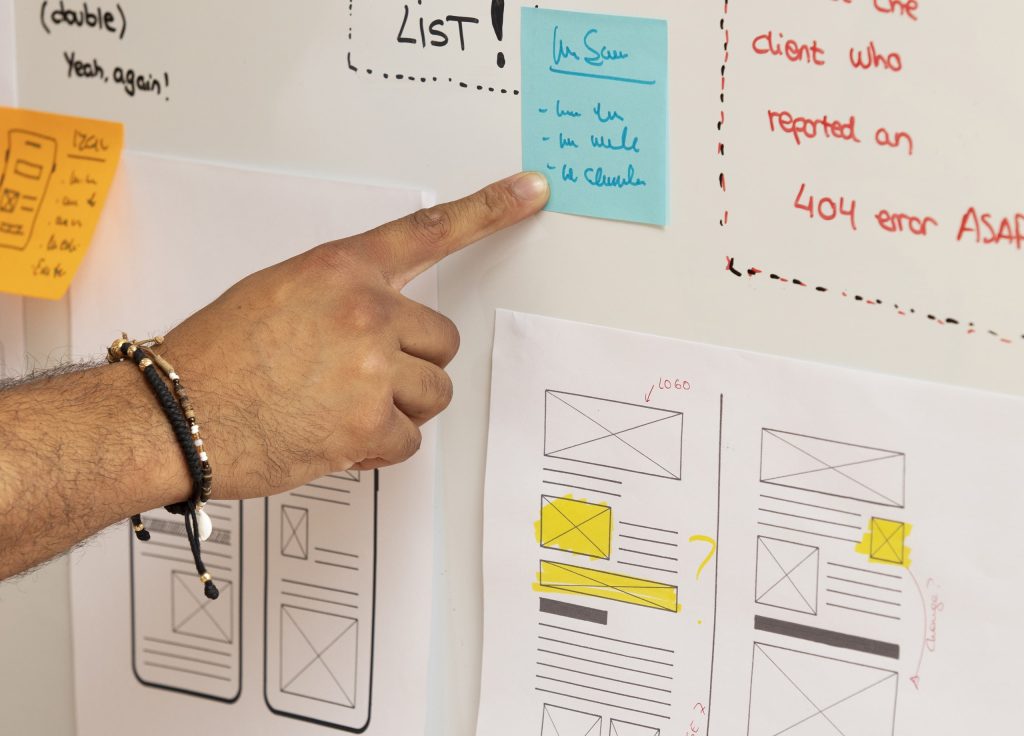- By TechLadz
- April 20, 2025
- UI/UX Design
User interface (UI) and user experience (UX) design carry far more weight in the digital age than aesthetics; they are about providing clarity, usability, and emotional connection. Every great digital product starts with structure at Techladz and changes through important interaction. We will lead you through the Wireframe to Prototype Process—step by step—in this manual so you may turn unaltered ideas into flawless, interactive experiences.
Creating an intuitive digital experience that captivates users calls for more than just beautiful interface design. It demands an organized approach that lets designers and developers to cooperate and run fairly. Wireframing and prototyping are very important in this respect. Successful digital design’s backbone is their ability to guarantee that the final product is technically possible and matches consumer expectations.
Knowing the basic distinctions and methods between wireframing and prototyping guarantees that your digital products are ideal aesthetically and practically. We should go farther into every stage of this change process.
Start with the Foundation: Understanding Wireframes
The skeletal framework of a digital product is wireframes. They eliminate interruptions and concentrate on layout, organization of contents, and navigational logic. Wireframes is the quickest approach to begin visualizing your idea whether you are creating a website, dashboard, or mobile app.
Early in the Wireframe to Prototype Process is a necessary step: Wireframing. It gives you the first sketches of your digital invention. It’s a map of sorts showing how the consumer will engage with your goods. At this time, you are not worried about colors, fonts, or imagery. Instead, you are concentrating on layout, organizational approach, and user flow across the website or application.
Why wireframing is important: It enables the team to concentrate on page features including headers, CTAs (Call to Actions), and navigation free of the clutter of final images. Wireframes let for early testing of layout and flow before investing in rigorous design or development. Wireframes provide a shared visual language among designers, developers, and stakeholders so that everyone agrees on the fundamental structure before getting into the specifics. This reduces the possibility of expensive errors farther down the line in the project.
Wireframe kinds: Rough drawings made on paper or software like Balsamiq; these low-fidelity wireframes are generally meant for fast ideation and brainstorming meetings. The primary aim right now is on the idea, not on perfection. These wireframes created with tools like Figma or Sketch display layout accuracy while still leaving out visual refinement. Although still early in the design process, high-fidelity wireframes provide a clearer view of the ultimate form of the product.
Move to Realism: Understanding Prototypes
Where wireframes give direction, prototypes animate your product. A prototype imitates the way consumers would interact with your goods. It helps to reveal points of friction and to coordinate people around a common aim—before writing any code.
More than just a visual image of a wireframe, a prototype is a completely interactive model. Wireframes emphasize design; prototypes stress the path a consumer follows across the product. Making prototypes allows you to validate the user experience with actual consumers, so crucially sharpening it.
Prototypes enable you to early on collect useful insights by watching actual users as they engage with your design. This is called real-time user testing. During this phase, user feedback helps to identify possibilities for improvement.
Design Validation: Customers get to see and feel the product before it’s constructed. Continuous improvement: Prototypes let you test ideas, check flows, and make fast changes to keep the vision in line with your expectations and help you understand the design more concretely. This speeds up one’s progression throughout the design process and makes them more adaptive.
Two kinds of prototypes are:
Low-fidelity: Basic clickable wireframes displaying user flows used mostly for rapid testing and user feedback collection. They are simple but they do the job for you when you need to verify ideas without investing too many resources.
High-Fidelity: Interactive mockups that closely mimic the ultimate experience. Visuals, transitions, animations, and more advanced interactions that mimic the final product are included in these prototypes.
Wireframe vs Prototype: Key Differences
Although they are both crucial elements of the design process, wireframes and prototypes process fulfill different roles. Concise navigation of the Wireframe to Prototype Process depends on knowledge of these variances. The following comparison of the two:
| Aspect | Wireframe |
Prototype |
| Visual Detail | Minimal, structure-focused | Detailed with color, fonts, and imagery |
| Interactivity | Static or low interaction | Fully interactive |
| Purpose | Layout planning | User testing and feedback collection |
| Common Tools | Balsamiq, Figma (low-fi mode) | Figma, Adobe XD, InVision (hi-fi mode) |
Though beginners may sometimes mix up wireframes and prototypes, it is vital to understand that both are essential for a thorough, iterative design process. Wireframes are best for establishing the foundations; prototypes bring the foundations to life and enable testing, validation, and improvement.
The Wireframe to Prototype Process – Step-by-Step
Research and Define the Vision
You need to know your consumers, rivals, and objectives before you even start drawing. The Wireframe to Prototype Process is based on this phase. Getting the knowledge and insights you need to guide your design choices is everything.
- Gather customer interviews and questionnaires: This way you get a clear idea of your target audience’s needs, actions, and pain points.
- Examine rivals to find gaps: Observing what rivals are doing allows you to find prospects for differentiation or enhancement.
- It is crucial that everyone is on the same page regarding specific business and UX goals. This guarantees that the end product matches corporate objectives as well as consumer requirements.
We sometimes begin with group exploration sessions at Techladz. By means of these programs, everyone is guaranteed from the first day, therefore promoting consistency and clarity.
Create Your Wireframes
It’s time to create the design of your experience once you have defined your vision. Wireframe helps here.
- For low-fidelity drafts, use quick sketches or Balsamiq: These early-stage wireframes help you investigate layout and structure without being crippled by the smaller details.
- Move to Figma or Sketch for high-fidelity wireframes, those that show a more precise view of the product, as you perfect your wireframe.
- Emphasize simplicity and a coherent architecture over visual aesthetics: First get your user flow and logical architecture in order before stressing about fonts, colors, or pictures.
Apply Visual Design Elements
After validating the wireframe, it’s time to layer in visual elements that reflect your brand identity.
- Choose typography and color schemes that reflect your brand: These visual elements help convey your brand’s personality and tone.
- Integrate iconography and imagery for clarity and emotion: Visual aids can make your interface more user-friendly and engaging.
- Apply consistent design systems to ensure scalability: Consistency is key for creating a seamless experience across different platforms and screen sizes.
Convert Wireframes into Prototypes
It is time now to transform your verified wireframe and visual design components into a dynamic, interactive prototype.
- Make sure the prototype accurately shows the planned user flow: This stage guarantee a smooth and intuitive experience.
- Link pages and simulate navigation: This allows users to experience how the product will function and navigate through the interface.
- Add hover states, transitions, and interactions: Increase user engagement by adding interactivity to your prototype.
At this juncture, tools like Figma and Adobe XD make it possible for real-time cooperation, therefore simplifying rapid iteration.
Test with Users and Iterate
The phase of the prototype is where ideas show themselves and improvement starts. Gathering inputs and enhancing the product depends in large part on user testing.
- Observe how consumers interact with your prototype and glean insights on their experiences during usability testing.
- Grasp comments on clarity, emotional reaction, and navigation: Knowing how users feel about the design is as important as how they navigate it.
- The iterative process is essential to perfecting the product and guaranteeing it satisfies user expectations; therefore, iterate fast and re-test to achieve a certain final version.
Document every design decisions and test findings; this pro tip Future initiatives and revisions will find this an invaluable resource.
Recommended Tools and Best Practices
Essential Tools:
- Figma: A powerful all-in-one design and prototyping platform.
- Adobe XD: Great for animation and micro-interactions.
- Sketch: Ideal for Mac-based teams with a robust plugin ecosystem.
- InVision: Excellent for stakeholder feedback and developer handoff.
Best Practices:
- Maintain a collaborative workflow across design, development, and stakeholders.
- Keep the process user-centered at every stage.
- Iterate early and often—don’t be afraid to go back and make changes.
- Document everything for learning, growth, and smoother handoff.
Conclusion
Once you have mastered the Wireframe to Prototype Process, you will be able to create digital goods that are ready for scale, interesting, and easy to use. Through research-driven design, team thinking, and ongoing iteration, we transform unprocessed ideas into polished, strategic interfaces at Techladz.
Starting off your Wireframe to Prototype Process with confidence—and let your audience guide you will help you get your vision realized.









